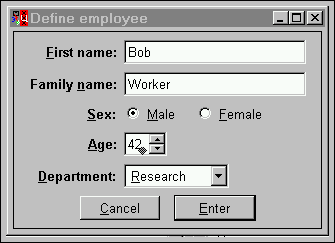





Before diving into the complexities we will illustrate normal usage through an example. The following Prolog predicate creates a dialog for entering information on an employee. The result, running on Windows-NT, is shown in figure 8.
ask_employee :-
new(Dialog, dialog('Define employee')),
send_list(Dialog, append,
[ new(N1, text_item(first_name)),
new(N2, text_item(family_name)),
new(S, new(S, menu(sex))),
new(A, int_item(age, low := 18, high := 65)),
new(D, menu(department, cycle)),
button(cancel, message(Dialog, destroy)),
button(enter, and(message(@prolog,
assert_employee,
N1?selection,
N2?selection,
S?selection,
A?selection,
D?selection),
message(Dialog, destroy)))
]),
send_list(S, append, [male, female]),
send_list(D, append, [research, development, marketing]),
send(Dialog, default_button, enter),
send(Dialog, open).
assert_employee(FirstName, FamilyName, Sex, Age, Depth) :-
format('Adding ~w ~w ~w, age ~w, working at ~w~n',
[ Sex, FirstName, FamilyName, Age, Depth]).
This example shows the layout capabilities of dialog and its dialog_item objects. Simply appending items will place items vertically and group buttons in rows. Labels are properly aligned. The enter button defines a call-back on the predicate assert_employee/5 using the values from the various controllers. Section 10.2 explains the use of message objects in detail.

| Figure 8 : Enter employee |